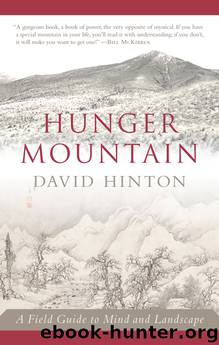Hunger Mountain by David Hinton

Author:David Hinton
Language: eng
Format: epub
Publisher: Shambhala Publications
然
(Thus)
In its full form, the top left pictographic element of 然 is 肉, meaning “meat” or “skin,” as we have seen, from the early graph . The top right element portrays a dog, the form a stylized version of the Shuo Wen’s , which derives from ancient oracle-bone images such as . And finally, on the bottom, is fire: , abbreviated form of 火, which is a simplified version of earlier fire images such as this oracle-bone rendering: . It’s an unlikely constellation of images, but I wonder if it might not explain why 然 became central to ancient China’s native cosmology.
然 appears in 自然 (tzu-jan), the term that means literally “self” + “thus” and translates as “occurrence appearing of itself.” Tzu-jan describes the Cosmos in its most fundamental form as female—forever generative, forever burgeoning forth from an Absence at its own heart. Our best view of this process must be Chinese painting and its rendering of Ritual cosmology. There, mountain landscape is dramatically suffused with Absence: the emptiness of sky and water, mist and haze. It seems landscape is emerging out of this emptiness, each form seething with the energy of transformation as it hovers on the verge of vanishing back into emptiness. And the same is true of the humans that so sparsely populate the mountains and rivers of these paintings: a fisherman on a thin slip of boat drifting across an empty expanse of lakewater, travelers wandering the boundary between landscape and empty sky or half-hidden where a path disappears behind a knoll, a village nearly vanished into mountain mist.
Taken individually, each of the ten thousand things seems to appear from Absence and return to Absence in a process of perpetual transformation, as in the paintings. But Absence should not be conceived in a spatial sense, for if that process is seen as an empirical whole, it’s impossible to locate Absence. There is only Presence, physical material evolving through one form after another, a process in which those forms all grow directly out of one another, not out of some ineffable emptiness. The structures of thought and identity are constructed from that Presence through metaphoric transference; and as identity is the entity that knows and linguistic thought is the medium of knowing, we can only know Presence. Absence lies always outside Presence and those metaphoric structures, so any knowledge of Absence is impossible. But it does nevertheless remain available to us.
Mountains are magisterial manifestations of Presence, so to walk up Hunger Mountain is to wander Presence and those metaphoric origins of thought and identity. That means one way to begin cultivating Absence is to simply stay home and not walk up Hunger. And today I am doing just that, inhabiting the silence of a house with my family gone: my wife visiting a friend, my daughter at school. And this is the perfect season for cultivating Absence: late autumn, season when the plenitude of summer (Presence) is being replaced with the emptiness of winter (Absence). The ancients
Download
This site does not store any files on its server. We only index and link to content provided by other sites. Please contact the content providers to delete copyright contents if any and email us, we'll remove relevant links or contents immediately.
The Lonely City by Olivia Laing(4751)
Animal Frequency by Melissa Alvarez(4399)
All Creatures Great and Small by James Herriot(4237)
Walking by Henry David Thoreau(3897)
Exit West by Mohsin Hamid(3779)
Origin Story: A Big History of Everything by David Christian(3651)
COSMOS by Carl Sagan(3559)
How to Read Water: Clues and Patterns from Puddles to the Sea (Natural Navigation) by Tristan Gooley(3410)
Hedgerow by John Wright(3280)
The Inner Life of Animals by Peter Wohlleben(3262)
How to Read Nature by Tristan Gooley(3252)
How to Do Nothing by Jenny Odell(3236)
Project Animal Farm: An Accidental Journey into the Secret World of Farming and the Truth About Our Food by Sonia Faruqi(3179)
Origin Story by David Christian(3149)
Water by Ian Miller(3129)
A Forest Journey by John Perlin(3027)
The Plant Messiah by Carlos Magdalena(2884)
A Wilder Time by William E. Glassley(2818)
Forests: A Very Short Introduction by Jaboury Ghazoul(2793)
